 Temple of Saptakoteshwar is located at Narve, about 35 km (22 miles) from Panaji, Goa. It is considered as one of the six great sites of temples of Lord Shiva in the Konkan area. This temple was held in great veneration by the ancient Goa rulers from the Hindu Kadamba dynasty. The temple is dedicated to Lord Shiva and is commonly known here as `Saptakoteshwar.`
Temple of Saptakoteshwar is located at Narve, about 35 km (22 miles) from Panaji, Goa. It is considered as one of the six great sites of temples of Lord Shiva in the Konkan area. This temple was held in great veneration by the ancient Goa rulers from the Hindu Kadamba dynasty. The temple is dedicated to Lord Shiva and is commonly known here as `Saptakoteshwar.`
History of Saptakoteshwar Temple
Saptokoteshwar temple has a chequered history that dates back to the 12th century. The temple was built by the king of Kadamba dynasty for his wife Kamaldevi who was a staunch devotee of Lord Shiva. This deity known as Saptakoteshwar was revered and worshipped by all the inhabitants of the Kadamba dynasty. They used titles such as Birudu, Shree Saptakotisha Ladbha Varaveera. They styled themselves as `Saptakoteshwar Labdha Vara Prasad` meaning under the blessing of the Goa Saptakoteshwar.
In 1352, the Bahamani Sultan Hassan Gangu had usurped the Kadamba kingdom and Goa was under the rule of the Sultan for about fourteen years. During this time many temples were destroyed. The armies also vandalized the linga of the Saptakoteshwar temple. Later the Vijayanagar King Harihararaya defeated the Bahamani Sultan`s troops and rebuilt the temple. The Saptokoteshwar deity was also restored. According to legends, the temple was reconstructed by Madhava Mantri by the end of the 14th century. After their peaceful reign of about two hundred years, the temple idol (linga) had to be removed once again to escape the raiding armies of the Portuguese conquerors but the temple was demolished in 1560. The stones of the temple were used for building a church there. The remnants of the temple ruins are still noticeable in the chapel attached to the cemetery of the church of Nossa Senhora da Piedade or the Our Lady of Compassion Church at Divar.
The idol of the Saptakoteshwar temple was abandoned for quite a long time during that period. It was however found near a well on the Divar Island. One side of the river bank was annexed by an ally of the Sultan of Bijapur who played a significant role in the rehabilitation of the linga on the river bank that remained visibly hidden amidst a narrow valley.
A new temple was however erected during the Shivaji`s reign following an incident. In 1664 Shivaji went to offer prayers to the linga that was placed in a mud in a thatch house. A straw from the thatched roof fell on his shoulders which he considered as a good sign. He then immediately ordered for the construction of the temple.
Architecture of Saptakoteshwar Temple
The architecture of the temple is based on the typical contemporary Goan architecture. Only the tall lamp tower or Deepastamba is designed in a distinctive style. The Saptakoteshwar temple has a small entrance hall with bells. The main five pillared hall is decorated with arches. The ceilings of the temple are designed with intricately designed with chandeliers and the sanctorum wall is made of plain wood. The Mandapa or pandal is designed in European style. The linga itself is distinctive of a `daralinga` type and made of polished stone. There is presence of ruins of ancient `aggarshalas` behind the main temple. The nearby environs of the temple are tinged with several Brahminical laterite and stone caves. The popular festival of Lord Krishna, `Gokul Ashtami` is celebrated here every year.



















